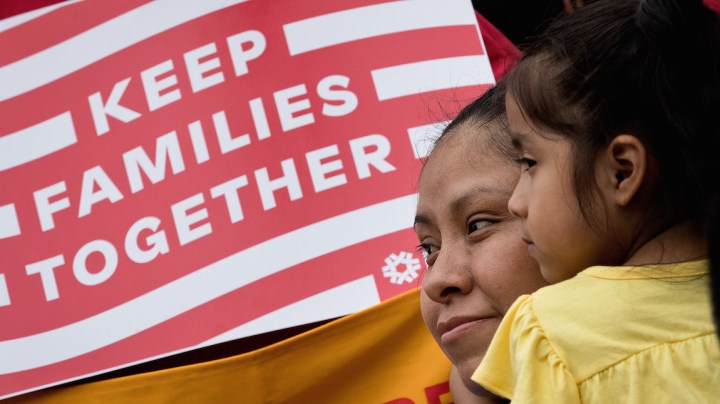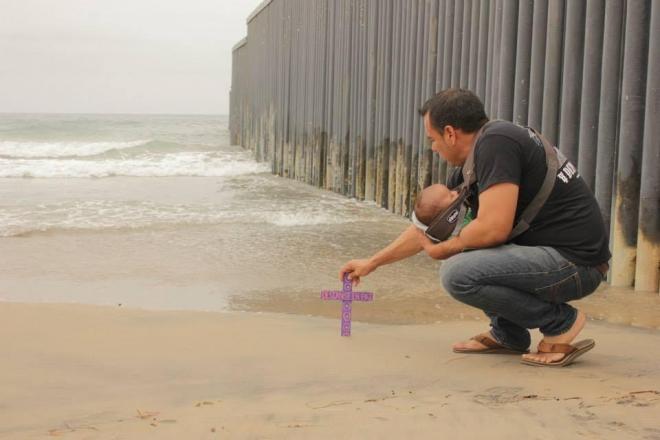Immigrant Rights Activist Hugo Castro Missing In Mexico After Posting Chilling Video

Mexican immigrant Nieves Ojendiz holds her 4-year old daughter Jane as she attends an immigration reform rally with members and supporters of the New York Immigration Coalition. Photo by rew Angerer/Getty Images News
UPDATE 4/18 5:20PM: According to a Facebook post from wife Gaba Cortes, Hugo Castro has been located. We will be following ongoing developments.
US-Mexico border activist Hugo Castro has dedicated his life to protecting immigrants that pass through Central and South America. But since he posted a panicked 20-minute Facebook Live video on Thursday before dropping out of contact with friends and family, fears have grown that the Baja California Border Angels coordinator may himself be the victim of violence.
“We are not going to permit — let it be very clear — we’re are not going to permit that Hugo Castro be one more on that interminable list,” says Castro’s fellow immigrant advocate and wife Gaba Cortes in a video she broadcasted on Saturday from a Baja California shelter their team is in the process of building.
A study by Mexico’s National Commission of Human Rights found that 1,600 of the migrants that Castro’s organization Border Angels and other advocates work to protect are kidnapped each month.
On Thursday afternoon, Castro was able to broadcast on Facebook Live for 20 minutes in the middle of Holy Week traffic on the highway between Mexico City and Puebla, possibly in Estado de México. He says a group of “criminals” caused him to separate from his caravan. In the broadcast, he fears for his life at the hands of these individuals, who he identifies as “adoradores de la muerte” and who he says are pursuing him with the intent to harm.
None of the vehicles are visible in the video, but Castro says his pursuers are in the process of surrounding him. The video ends abruptly.
Castro was en route to the Víacrucis del Migrante, an annual march from Central America to Tijuana that brings attention to the dangers migrants face on their journey through Mexico.
This year, the march started on Palm Sunday in Petén, Guatemala. On the night of Easter Sunday in Ixtepec, Oaxaca, some 200 Víacrucis marchers boarded “La Bestia,” the network of trains many immigrants ride on their way north. The train was halted by officials and now the procession has splintered, with a delegation currently on its way to Mexico City with hopes of presenting its concerns over immigrant safety to the Senate.
Border Angels organized its own caravan to the march for 13 years, but in recent years, they have supported a caravan planned by Pueblo Sin Fronteras.
Border Angels executive director Enrique Morones — who is also the godfather’s of Castro’s child — tells Remezcla that Castro approached him a few weeks ago with a plan to drive of Pueblo Sin Fronteras’ support vehicles from Sonora to Mexico City.
Morones says he has “no doubt” that the Castro was targeted because of his activism, adding that a few weeks ago Castro’s life was threatened by Tijuana taxi drivers whom the activist had accused of charging exorbitant fees to recently deported immigrants.

“I don’t think that group is so sophisticated that they have people [in the area where Hugo shot his last video,]” says Morones. “But in Hugo’s case, the times he’s been threatened with violence, it’s been because of his work.”
Morones adds that he — and most high profile immigrant advocates — have been targeted for violence because of their activism.
Castro’s friends and family had been on high alert since last Wednesday, when Morones says one of Castro’s inner circle received an “unusual message” from the activist.
“I had a kind of sense that something was going on, that he was in trouble,” says Morones.

Many questions remain. When was Castro separated from his caravan and the vehicle he was driving? Why didn’t he ask for help at the gas station clearly visible in his last video? Who are the “adoradores de la muerte”?
Some experts believe the video may not be what it seems.
“My first thought is that this is a weird way for him to communicate in a situation of extreme distress,” says Guadalupe Correa-Cabrera, an associate professor at University of Texas Rio Plata and author of the forthcoming book Los Zetas Inc.: Criminal Corporation, Energy, and Civil War in Mexico who has done extensive work on crime and trafficking in Mexico.
Correa-Cabrera says she was contacted last year by immigrant rights activists who had been harassed by individuals in masks; the activists suspect these individuals were connected to the Estado de México company in charge of security in La Bestia’s southern states.
She points to the case of Tamaulipas crime reporter María del Rosario Fuentes aka Miut3, whose Twitter account was hijacked by her own murderers, posting images of her corpse accompanied by explicit threats that similar fates would befall those who insisted on reporting on cartel activity.

“This seems like an attempt to provide a message of others doing the same work to stop doing it,” Correa-Cabrera says of the Castro video. “This is the way that I see it.”
Castro is a US citizen who was born in Salinas, Mexico and who currently lives in Tijuana. There, he coordinates Border Angels’ “SOS Migrante” campaign of shelter donations in Baja California, where aide organizations have been overwhelmed since the US cut off entry to Haitian refugees.
“I don’t believe in the (Mexican) leader, I don’t believe in the U.S. president,” Castro recently told a reporter. “But I do believe in the people. So we, the people, el pueblo, are the ones who are bringing the change.”
Mexico continues in its battle against cartel violence and governmental corruption. The news of Castro’s disappearance was followed quickly by the fourth murder of a journalist in six weeks and the apprehension in Guatemala of Veracruz governor Javier Duarte, who has been accused of grafting millions of dollars from his government and who had been on the lam for six months.
Vigils took place over the weekend of supporters praying for Castro’s safe return. Cortes said that any reports that her husband has been located are false and has asked that those concerned follow her Facebook page for the most reliable updates on Castro’s disappearance.